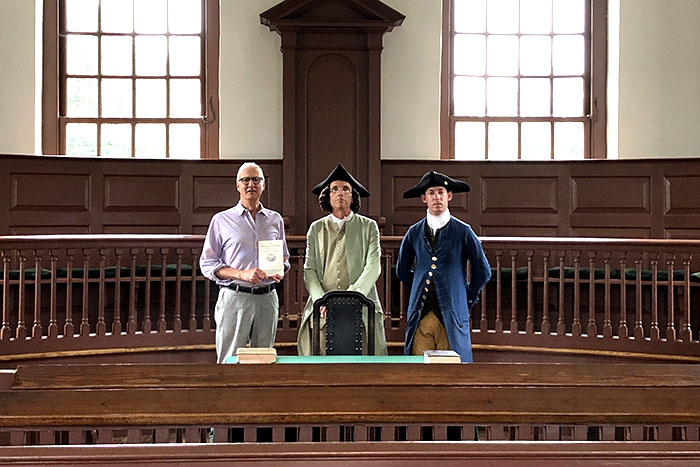History, Engineering Collaboration Produces New Findings about Colonial Virginia

Col. Turk McCleskey, professor of history, poses with historical interpreters at the Williamsburg Courthouse; not pictured is Col. Jim Squire.—Photo courtesy of Col. Turk McCleskey.
LEXINGTON, Va., Oct. 23, 2019—What happens when a history professor meets an electrical engineer? At most schools, the answer might very well be “nothing.” But at VMI, the answer is a successful collaboration that’s been going on for over a decade and has now resulted in the publication of four scholarly articles.
This summer, The William & Mary Quarterly, published “Knowing When to Fold: Litigation on a Writ of Debt in Mid-Eighteenth Century Virginia.” The essay is the result of years of work on the parts of Col. Turk McCleskey, professor of history, and Col. Jim Squire, professor of electrical engineering.
McCleskey’s interest in debt litigation among residents of colonial Virginia began several years ago as he was doing research for a book he would ultimately publish in 2014, The Road to Black Ned’s Forge. As he worked, McCleskey found that Edward Tarr, the main character of the book title and the first free black landowner west of the Blue Ridge, had been involved in more than one lawsuit having to do with the collection of debt.
But when McCleskey went to put that finding in context, he ran into a brick wall. “I couldn’t say if that was significant or not,” he explained. “I started looking around and there was no literature that said this is what’s normal for litigation, this is what to expect.”
At that point, McCleskey had to just keep going and finish the research for his book, but he came back to debt litigation as a research interest later. He’d obtain court records on microfilm and enter them one by one into a database on his laptop.
The process was slow enough as it was, but then McCleskey, a Marine Corps reservist, faced an additional challenge when he was deployed to Guantanamo Bay, Cuba, from 2005 to 2007. The Marine Corps took over his daytime hours, so McCleskey used the evenings to his advantage.
“In the evenings, on my own time, I’d put on a baseball game and sit there and compile the data,” he commented.
By the time his deployment ended, McCleskey had data on approximately 3,600 lawsuits and 5,000 property transactions. Shortly after he returned to VMI, he ran into Squire, who asked, “What did you do for fun while you were down there?” When McCleskey explained what a tremendous volume of data he’d acquired, Squire volunteered to come on board as a number cruncher.
Just how much work McCleskey had put in by that point is almost impossible to overstate. “Until [McCleskey] came, these [records] were all hand-lettered using quill ink pens in ledgers in different courthouses scattered all through Virginia,” noted Squire. Banks didn’t exist, McCleskey explained, and debts were often recorded on slips of paper.
Amassing the data, though, was just the first step. The next step had to do with determining what kinds of stories the data could tell. Very quickly, McCleskey and Squire learned that colonial Virginians were much more litigious than their modern-day counterparts. On average, each person was involved in one lawsuit every nine years.
That in itself was newsworthy—but there was more. In the most recently published article, McCleskey found that the high volume of debt litigation bolstered support for the courts, which carried out both executive and judicial functions in colonial times. The court might order a landowner to come together with his neighbors and fix the road, for example, or grant a license for a tavern.
“The county court is making decisions that have daily ramifications for people,” McCleskey explained. “There’s no popular input, no voting, for the people who are telling you what to do. You hope that the legal system is sufficiently impartial that you are going to get justice if it’s due to you.”
One might suspect that this system would lead to unrest—yet it did not, and Squire’s analysis of McCleskey’s data shows why it did not.
Using a decision tree, Squire graphically showed in the article that in the five Virginia counties included in the study—Augusta, Middlesex, Richmond, Surry, and York—only about 5 percent of the court cases initiated between 1746 and 1755 went to trial. What’s more, McCleskey added, in the cases that did go to court, the evidence was very clear.
Because of this, the history professor noted, citizens were likely to conclude, “There’s nothing wrong with the courts. Everybody’s making good decisions … the judges must be okay.”
The county court system of colonial times, as odd as it may seem to modern sensibilities, “is a great example of a non-democratic but stabilizing process,” said McCleskey.
For his part, Squire doesn’t see his role in supporting McCleskey’s research as unusual.
“My job is essentially applied mathematics,” he stated. “An engineer does applied mathematics to solve social problems.”
McCleskey, meanwhile, is grateful for Squire’s willingness to share his skills. “I don’t have the ability to do anything more than see the potential in all of this,” he noted. “I can build an accurate data set, but I can’t drive it around the block.”
McCleskey also had a funny observation about his and Squire’s most recently produced collaboration.
“The weirder pairing isn’t the co-authors,” he observed. “Not since it was founded in 1892 has The William & Mary Quarterly published an article with a country-western allusion in the title.”
– By Mary Price
.svg)
.png)